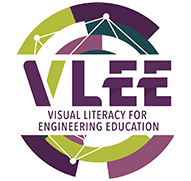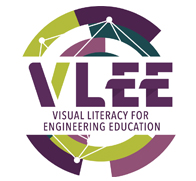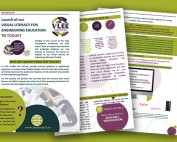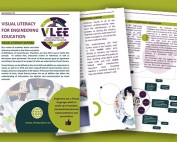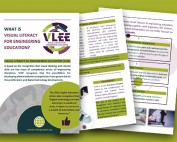More about VLEE
 Visual Literacy for Engineering Education (VLEE) is based on the recognition that visual thinking and related skills are a key area of competence for today’s engineers across all engineering disciplines because of the relationship between spatial reasoning and graphic representation to problem solving and creativity. It recognises that the possibilities for developing these competences have grown exponentially thanks to the proliferation of digital technology.
Visual Literacy for Engineering Education (VLEE) is based on the recognition that visual thinking and related skills are a key area of competence for today’s engineers across all engineering disciplines because of the relationship between spatial reasoning and graphic representation to problem solving and creativity. It recognises that the possibilities for developing these competences have grown exponentially thanks to the proliferation of digital technology.
The October 2017 European Council called for training and education systems to be ‘fit for the digital age’ and the 2018 Digital Education Action plan recognizes that “Digital technology enriches learning in a variety of ways, it opens up access to a wealth of information and resources.”
 Yet while digital technology is pervasive in our social lives -more than 80 % of young people in Europe use the internet for social activities (Eurostat, 2015)– the use of technology for educational purposes lags behind. This is especially evident in visual literacy: today’s students are expert consumers of global visual media messages, but as EU work on digital media literacy reveals, often lack the skills necessary to move beyond being passive receivers of this information.
Yet while digital technology is pervasive in our social lives -more than 80 % of young people in Europe use the internet for social activities (Eurostat, 2015)– the use of technology for educational purposes lags behind. This is especially evident in visual literacy: today’s students are expert consumers of global visual media messages, but as EU work on digital media literacy reveals, often lack the skills necessary to move beyond being passive receivers of this information.
VLEE will help remedy this situation by pursuing the provision of visual literacy for engineering training in our VET system through the following objectives;
- The Competence Framework (IO1) is a concerted effort to structure and communicate the engineering-specific components of visual literacy in a way that speaks the language of educators, addressing the specific gaps in their knowledge
- the Toolkit (IO2) is aimed directly at teachers and trainers who wish to increase the quality of their teaching using digital visual media tools, but are unsure which tools to use and how to use them.
- the Online Course (IO3) complements classroom work, providing teachers a practical resource to help consolidate student’s skill.
 This project will enable engineering students to adopt a more proactive and strategic use of digital visual technology in their learning (and future practice) of engineering. By teaching them how to think, reason, interpret and communicate visually through media such as mind maps, infographics, technical sketching, 3D imaging, vlogging, video explainers, and more it uses to technology to reinforce their engineering-specific cognitive skills and contributes to important transversal skills in digital literacy, particularly the third competence area in the European Digital Competence Framework for Citizens, “digital content and creation.”
This project will enable engineering students to adopt a more proactive and strategic use of digital visual technology in their learning (and future practice) of engineering. By teaching them how to think, reason, interpret and communicate visually through media such as mind maps, infographics, technical sketching, 3D imaging, vlogging, video explainers, and more it uses to technology to reinforce their engineering-specific cognitive skills and contributes to important transversal skills in digital literacy, particularly the third competence area in the European Digital Competence Framework for Citizens, “digital content and creation.”
The project will impact at a national level by bestowing a deeper understanding of the relevance of “soft” transversal skills such as visual literacy to engineering education and a recognition that innovative pedagogic strategies can make these competences highly “teachable” even within traditional engineering courses. While at a European level the project is designed to contribute to a shift in understanding of the role of VET Institutions, and in particular Engineering teaching, in contributing to transversal competences such as visual literacy and our ability to produce well-rounded engineers that flourish in the world of work.
